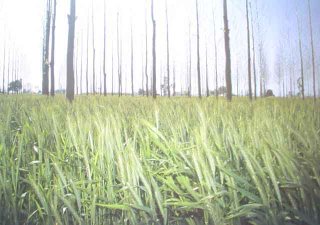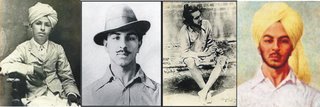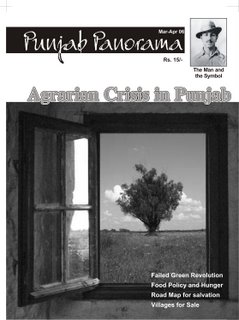 The story of agriculture in modern Punjab is remarkable for its complex plot. Still unfolding, the story has all the ingredients that make it hard for the main actors in the story to shape up the desired climax. Punjab Panorama in its latest issue pieces together different sub-plots of the story.
The story of agriculture in modern Punjab is remarkable for its complex plot. Still unfolding, the story has all the ingredients that make it hard for the main actors in the story to shape up the desired climax. Punjab Panorama in its latest issue pieces together different sub-plots of the story.The exhilaration of green revolution has given way to despair. The state which reaped the benefits of the Green Revolution in the 80s has come to fight a failing battle with farmer suicides. It has been conclusively proven that there is no direct relationship between progress in agriculture and economic lot of those practicing it.
The Punjabi farmer hailed as saviour, once is being pushed to fringes in the overall economic scenario. Never a master of his own destiny, the control is being increasingly taken.
What do our experts have to offer by way of remedy?
The Second Green Revolution
The discourse on the continuing crisis in agriculture has traveled from 'Diversification' to 'second green revolution' with no consensus yet.
The committee led by Dr. S.S. Johl, chairman of Punjab Planning Board, came up with 'Crop Adjustment Programme' asking for compensating the farmers for not sowing wheat and paddy. The scheme envisaged that area with paddy and wheat cultivation would be replaced by alternative crops and the farmers will be paid in cash for opting for this. Experts picked holes in the scheme. It?s impossible to implement for the sheer size being targeted besides other reasons, countered Dr. S.S. Shergill from Panjab University, Chandigarh. According to Dr. S.S. Rangi, currently consultant to State Farmers Commission, "at present, the diversification options are limited and mostly uneconomical for the farmers to adopt." Punjab should stick to wheat and paddy, Dr. Shergill went on to suggest. "The salvation of Punjabi farmers lies in further improving their efficiency and competitive advantage in wheat and rice production," according to him.
Prime Minister Dr. Manmohan Singh reminded in a brain storming meeting on farmers and farming in Punjab organized at PAU in 1998 that the diversification alternatives are capital intensive, risk prone and sensitive to market fluctuations. "It is therefore, important to conduct sensitivity analysis by using modern analytical techniques including probability analysis" he warned at that time.
Incidentally, it is the same Dr. Manmohan Singh, now in his avatar of Prime Minister of India, who is credited with the propagation of the term 'second green revolution' in Indian context. When M.S. Swaminathan, considered the father of the Green Revolution in India and now unabashed promoter of GM crops, called his international conference held in August 2004 in New Delhi, second green revolution, some of the contours of this were made clear. The conference was organized by the MS Swaminathan Research Foundation in partnership with the Federation of Indian Chambers of Commerce and Industry (FICCI) and the biotech industry-backed International Service for the Acquisition of Agri-Biotech Application.
We don't have all specifics of what this second green revolution would be, yet, but suddenly everybody is talking about it.
President A P J Abdul Kalam in his address to the nation on the eve of the 54th Republic Day said "... It is the right time for India to embark upon the Second Green Revolution, which will enable it to increase its productivity in the agricultural sector." The second green revolution is indeed graduating from grain production to food processing and marketing, he said. Prime Minister Manmohan Singh called for private-public sector partnership for ushering in a second green revolution in the country at a different occasion.
A report by a government-appointed task force headed by Professor M. S. Swaminathan, says: "India's nearly 110 million rural families - mostly peasant farmers owning up to two hectares of land - will have to be provided with the ?best available technologies such as biotechnology and information, space, nuclear, renewable energy, and precision farming technologies and scientific organic farming methods."
Science & Technology Minister Kapil Sibal goes a step further, anointing transgenic research the "most crucial component of Indian agriculture."
With our mainstream media echoing what the government and our scientific establishment have to say, it is important to make out what this actually translates to. According to Peter Rosset, the executive director of Food First/The Institute for Food and Development Policy, calls it "green revolution myth" and asserts that for those who remember the original "Green Revolution" promise to end hunger through miracle seeds, this call for "Green Revolution II" should ring hollow. Yet, Monsanto, Novartis, AgrEvo, DuPont, and other chemical companies who are reinventing themselves as biotechnology companies, together with the World Bank and other international agencies, would have the world?s anti-hunger energies aimed down the path of more agrochemicals and genetically modified crops. This second Green Revolution, they tell us, will save the world from hunger and starvation if we just allow these various companies, spurred by the free market, to do their magic.
Dr. Vandana Shiva had a warning as far back as 1991, that second green revolution cannot succeed where first has failed. The Green Revolution has been a failure, according to Dr. Shiva. It has led to reduced genetic diversity, increased vulnerability to pests, soil erosion, water shortages, reduced soil fertility, micronutrient deficiencies, soil contamination, reduced availability of nutritious food crops for the local population, the displacement of vast numbers of small farmers from their land, rural impoverishment and increased tensions and conflicts, she says and the beneficiaries have been the agrochemical industry, large petrochemical companies, manufacturers of agricultural machinery, dam builders and large landowners.
Normal Borlaug, eminent scientist and Nobel laureate credited with ushering in the green revolution in Mexico that led the way to it being replicated in Indian sub-continent, never ever seriously joined the issue with the critics on specific concerns raised by them. While admitting that his work had not transformed the world into utopia, however, he maintained that it was a change in the right direction. On the criticism all he has to offer is that the critics have never experienced the physical sensation of hunger doing their lobbying from comfortable office suites. "If they lived just one month amid the misery of the developing world, as I have for fifty years, they'd be crying out for tractors and fertilizer and irrigation canals and be outraged that fashionable elitists back home were trying to deny them these things," according to Borlaug.
Players in Food Business
Where does all this place the farmer? The establishment would have us believe that the farmer is a player in the international trade in agriculture produce so that agriculture can contribute to India's economic growth. This is the line being pursued by our PM, an economist by training. The big picture scenario, impressive as it sounds, may dwarf the farmer also in the process, is the fear.
The food business is international business and an important business at that, at the core of all human activity. Being played by big players the rules of this business game are decided by those very players.
Devinder Sharma, agricultural scientist and food policy analyst, says the agricultural policies are being launched at the behest of the United States. Sharma warns that in the U.S., which is marketing the second Green Revolution, the industrial-farming systems survive on massive farm subsidies. Despite more than $75 billion being provided every year in farm support, farmers have preferred to exit agriculture. Remove these subsidies, and American agriculture will most likely collapse like the proverbial house of cards. In any case, American farmers too are abandoning agriculture. In 2002, there were some 900,000 farmers. By 2004, in two years time, the number had come down to 700,000.
Devinder Sharma calls it a "faulty model" which is being replicated here. In the European Union, too such an alarming situation exists despite the availability of direct subsidies to farmers. With rural infrastructure in place and the supply chain system linked to retail business in operation, there is no reason why agriculture should still be a losing proposition. Without even questioning the merit and economics of an agribusiness model that displaces farmers, India is aggressively adopting it.
The plan has actually been put to paper and named, 'Indo-U.S. Knowledge Initiative on Agriculture Research and Education'. Rs 1000 crore project will set the agenda for collaborative farm research with Indian laboratories and agricultural universities. Completing the picture of Indian agricultural research yoked to the US private bandwagon is the fact that the US-based multinationals, Wal-Mart and Monsanto, are on the board of the project. The US side has made clear that any funding that comes to this initiative from the US side will be from the private sector.
How is the American private sector going to influence the Indian agricultural scene should not be difficult to fathom. Wal-Mart food chain and the Monsanto Seed Corporation are keen on using the Initiative for retailing in agriculture and on trade aspects. Transgenic research in crops, animals and fisheries would be a substantial part of the collaboration in biotechnology, requiring India to pledge huge funds.
Writing in CPI(M)'s mouthpiece, Prabir Purkayastha argues that corporatising agriculture will do little to help the bulk of the rural population. With its focus on commercial crops, bulk procurement and retail chains, such corporatisation can only weaken the small farmer even more. Already in Punjab, corporate interests such as Monsanto, Reliance and others are making a beeline for agri-retail trade. With gradual withdrawal of the Government from procurement, more and more of retail trade for agriculture is going pass into these hands. The presence of Wal Mart on the US side also makes clear the interest that the US has in opening India?s internal and external trade in agriculture to US companies.
Unlike in the days of first Green Revolution, agricultural research has now been largely privatised in the US. The Green Revolution grew from an international public research system that began in the 1940s and built up a chain of research centres worldwide. These centres collaborated through the Consultative Group on International Agricultural Research (CGIAR), a consortium of donors including foundations, national governments, United Nations institutions, etc. These centres operated in a world without Intellectual Property Rights and distributed seeds and new varieties all over the world. The striking improvements of yields in a number of crops, particularly wheat, rice and maize came out of this open institutional structure of science and research.
This is a fundamental shift in science that has taken place, argues Purkayashtha. Earlier, all advance stemming from publicly funded research was supposed to be in the public domain. However, in the US, it changed with the Bayh Dole Act of 1984 that allowed knowledge created by public funding to be patented. This has been followed in most countries with public institutions joining the private sector in the rush for patents. The problem here is that such patents held by public institutions are not used for public good but in turn are licensed to private companies. The university or the public institution may get a large revenue as a result, but the public does not get any benefit to this public funding of such research.
Therefore, even the institutions that helped in the first green revolution are pursuing a different agenda today. They are so closely tied up with agribusiness in the US that instead providing help to our agricultural research, they are more likely to be allied with big agribusiness.
Says Anuradha Mittal, Co-director of the Institute for Food and Development Policy, "I wish it were true that U.S. aid came zfrom a generosity of spirit, but it has always been a political tool used to control the behavior of Third World countries ?.. for finding new markets for U.S. agribusiness, and now for dumping foods containing genetically modified organisms, which are being rejected by consumers in the West."
The policymakers have been talking about the need to bring in private capital in a big way in Indian agriculture as the only solution to the agrarian crisis in the country. With its focus on commercial crops, bulk procurement and retail chains, how will this corporate model of agriculture work for farmers is the question that is not being addressed, though.
"It?s strange that the country has already jumped into the second phase of green revolution without first drawing a balance sheet of the first phase of the technology era," laments Devinder Sharma.
No Informed Choices
In the 1970s when they were given the choice of high-yield varieties of seeds along with chemical pesticides, they welcomed both with equal enthusiasm. Desperate enough to try anything the farmers now are welcoming GM technology throwing caution to winds. It has been shown just recently in the cotton belt of the state where farmers took to Bt cotton with gusto.
The farmers don?t have a choice otherwise also. The classic case is the debate on paddy-wheat rotation in Punjab. Paddy is a farmer guzzler, the farmer need not be told that any longer. Then why doesn't he shift to other crops? Ask any farmer and he will shoot back, what choice do I have?
The Economics
It's ironic that the lack of choice does not mean that the choice availed by farmer is economically viable also. Ask any farmers and he has his statistics ready. Nirbhay Singh of village Ahmedgarh near Ludhiana claims he earns Rs. 10 per acre daily from 8 acres he tills. This includes 4 acres taken on theka, less than the labour he employs he earns. So why doesn't he opt out? What else do I do, is the counter question. This is the only vocation he knows and has been doing for more than forty years now.
Things were not as bad back then. Harbans Singh of Mahianwala in Ferozepur district tells as far back as 1997, when he started farming after retiring from army, urea cost around Rs 200 which is Rs 250 now. Diesel was Rs. 15 a litre, which has doubled now. Every input cost has increased manifold but the prices they are getting are not increasing proportionately, is the simple economics of the problem. This economics gets all the more skewed when you factor in the social costs. There has been a tremendous increase in the household expenditure and money spent on marriages and booming consumer goods etc. This brings in the sociological viewpoint to the economic angle marking out the complexity of the crisis.
Political-Ideological Angle
This is the crucial angle on which hinges the roadmap of agriculture. In continuance of the economic policies being followed by state, agriculture model tailored to the needs of market is the government answer to the crisis. There is clear polarisation of views on efficacy of the view that the market that take care of its own will take care of agriculture too or not. However, the government seems to be clear on which direction to go.
It remains for the non-governmental campaigners to strike discordant notes while the state machinery sets upon to implement its agenda for agriculture. Scepticism on this vision of agriculture is no match for the establishment?s unbridled enthusiasm - echoed by the mainstream media.
They have promised light but for now it's a long dark road ahead for the farmers.
-Jatinder Preet
-Jatinder Preet




